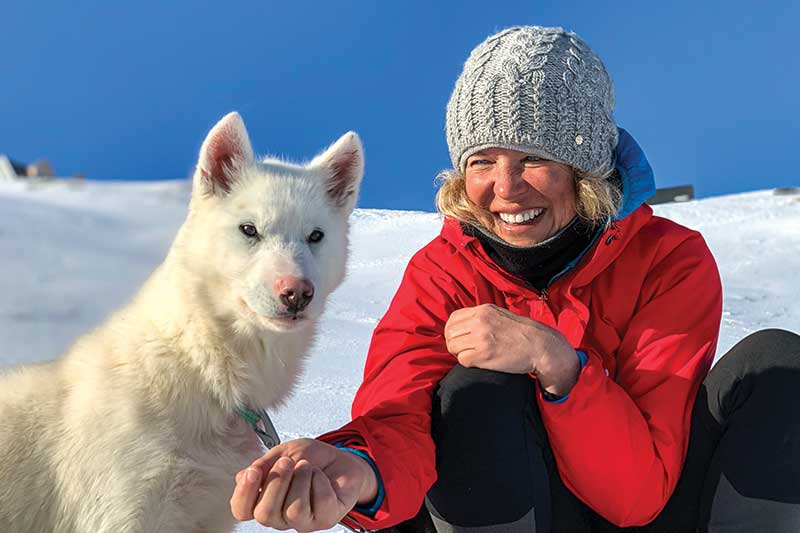Freediving in Epic Greenland
Today the world’s largest island is being rediscovered – not by vikings, but by divers who travel to the Arctic in search of encounters with modern giants: whales, glaciers, and icebergs
Words and Photography by Tobias Friedrich
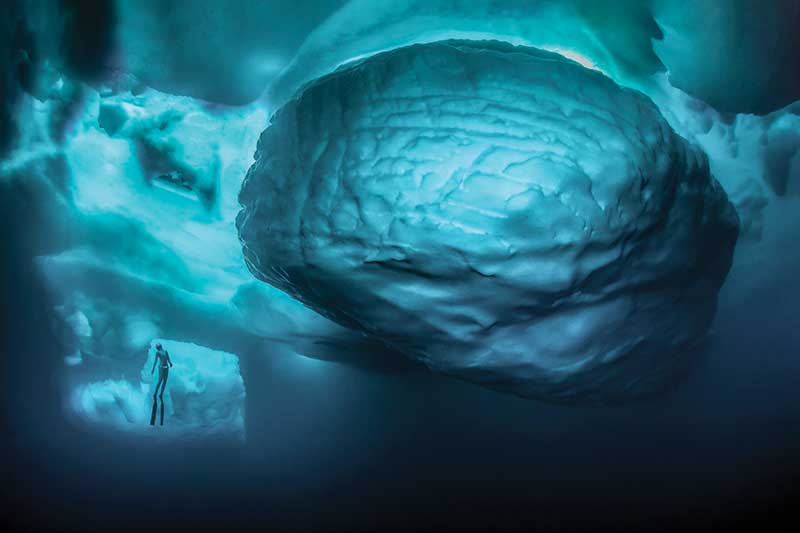
Greenland is unique. The landscape is stunning—so too, the freezing cold and silence. Until you actually arrive in Greenland, you have no idea what the conditions—especially the ice conditions—will be like. It can be that the weather doesn’t allow you to be outside, like when a storm is coming. I had been diving on Greenland’s icebergs twice before, once in summer and once in winter, so I knew a little of what to expect. But this time my expectations were that everything would be different.
It was 2019 and before the global lockdown and I was travelling with the famous German freediver, Anna von Boetticher. Anna holds 33 national records, making her Germany’s most successful freediver. In 2018 she had travelled to Antarctica to dive on icebergs but was unable to dive because of bad weather conditions. The plan this time was to make another attempt—in the Arctic.
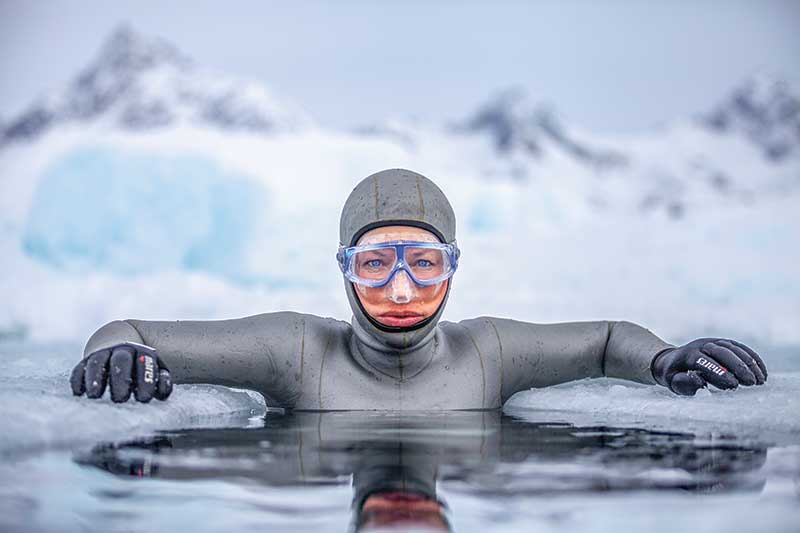
Over jagged ice
In East Greenland, March is still very cold and the pack ice stretches far from the fjords into the Atlantic Ocean. Boats are of no use at this time of the year, especially not in the frozen fjords. We had to take all of our equipment by helicopter from the only airport in East Greenland, Kulusuk, to the town of Tasiilaq, which is home to about 2,000 people. Prepared for periods of bad weather, we stayed there for a total of two weeks and expected a few days on which we could not dive. Fortunately, the ice and weather conditions were perfect when we arrived: the Tasiilaq Fjord outside the city was completely frozen in a 12 to 18 inch (30 to 50cm) thick layer of ice, with blue sky and almost no wind.
Some smaller icebergs that we wanted to dive were frozen in the fjord but getting to them was a challenge. A snowmobile made it easy to transport the diving and photo equipment across the ice, but we couldn’t get all the way to the dive site because the ice was too uneven for the snowmobile. We had to pack the equipment on small sleds and pull them over the jagged ice for the last few hundred yards/metres to the dive site. That meant moving a few hundred pounds of equipment back and forth through the deep snow every day. Once at the icebergs, holes had to be sawn in the thick ice cover—one for entry and exit, and three or four others to act as safety holes.
Heavy physical activity in the sheer cold is not without ramifications. In thick clothes you sweat very easily, which is usually not a problem, but can become one under these conditions. If you sweat too much before the dive and then put on your drysuit, the sweat has nowhere to go and cools off on the skin as soon as you are in the water. With a water temperature of almost 28˚F (-2˚C)—the freezing point of salt water—this can quickly become a problem and end the dive after a few minutes. Our solution was to do the activities on the ice as a team and take turns so that we didn’t sweat too much.
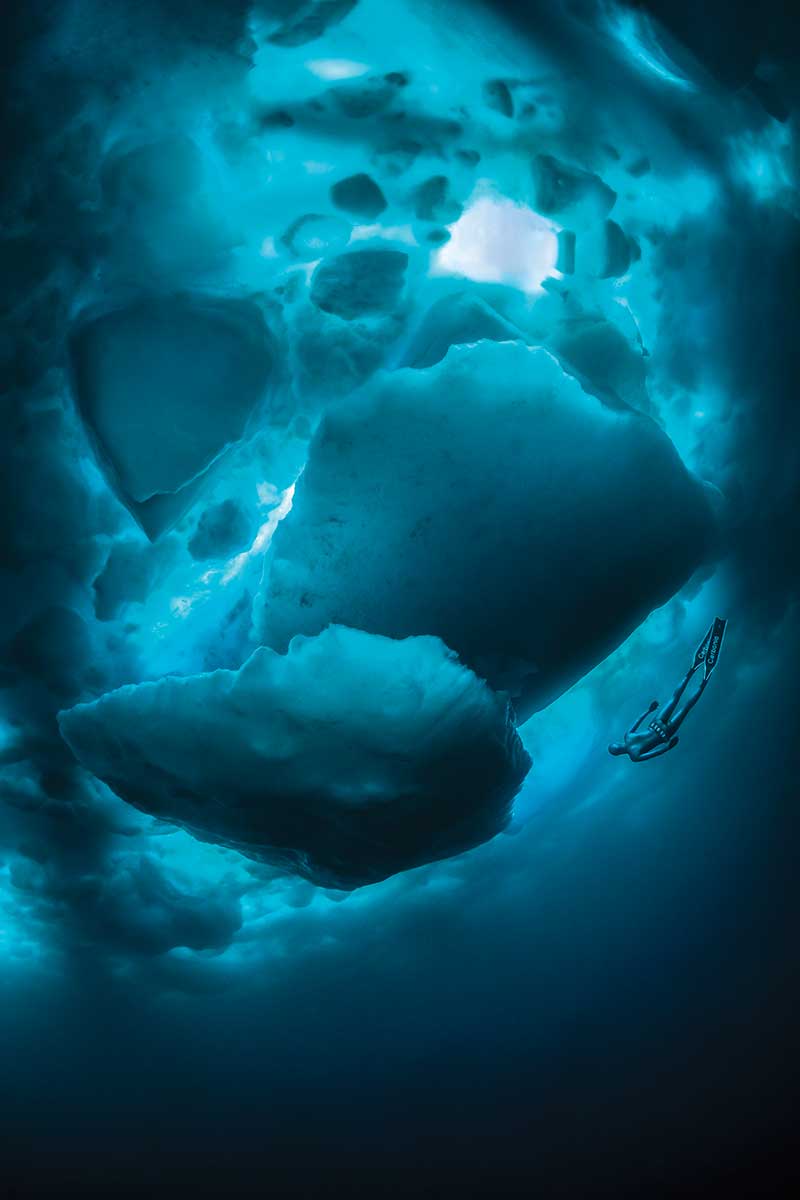
Your lips go numb
We anticipated issues with regulators and diving equipment. The top layer of water is covered with fresh water, which freezes faster than salt water. This meant that at the surface you couldn’t breathe through your regulator, as it would freeze immediately, causing it to free flow (i.e. when the second stage freezes and constantly blows air through the valve). Our safety limits and standards therefore had to be much higher than for a normal dive. The trick was to let yourself sink to at least three feet (1m) depth and only then take your first breath. It was a bit of a challenge to fully rely on the equipment in those conditions, but that’s the only way it works. For repetitive dives, it was very helpful to pour hot water into the second stage and into the inflator of the BCD, which would also freeze. Once in the water, it felt like a normal cold-water dive, except that your lips and parts of your face were exposed to the icy water. But after a few minutes these parts go numb and stop hurting.
Once you’re in the water, how quickly you get cold is an individual thing. People with poorer circulation tend to get cold faster, others don’t mind for a long time. Being in the water for 30 minutes shouldn’t be a problem for anyone but staying longer requires either strong mental endurance or lots of physical activity to keep the blood flowing. As soon as you come out of the water, your body heats up quickly again, especially your hands. But if you stand on ice all day, your feet never really get warm. Pouring hot water into your boots (not inside the dry suit, of course!) warms up your feet very quickly. With no wind and hot tea, it’s easy to warm up between dives. When there are storms and low outside temperatures, everything becomes much more difficult. One day we had an outside temperature of almost -4˚F (-20˚C) and a strong wind, which makes it feel more like -22˚F (-30˚C). After a few minutes out of the water, anything that is wet will freeze, including your drysuit.
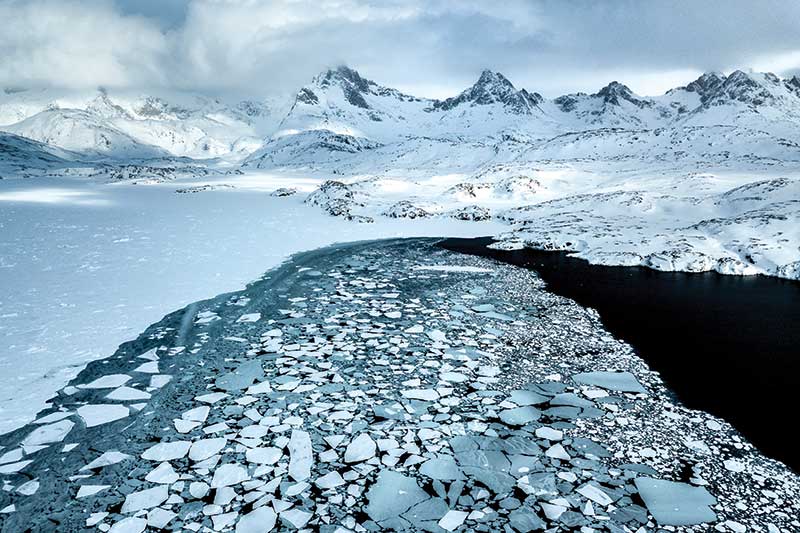
A real trouper
Anna wore a 6 mm wetsuit, which could only keep her warm to a limited extent. But due to her mental fortitude and constant movement, she was able to stay in the water for almost 15, sometimes up to 20 minutes, which gave me enough time to take pictures of her next to the icebergs. This was key, as we were doing several dives a day whenever possible, changing locations to see varied scenes under the ice. For us it was also very important to show the viewer the dimensions of the frozen icebergs. Since no other diver was in the water with us, Anna had to trust me absolutely. I always watched her closely on her way back to the exit hole, although my instinct was to look at my pictures immediately, as I normally do. But the importance of this additional safety measure became evident when on one dive Anna came up a little short and couldn’t find the exit hole. I was alerted to the situation when I noticed her look around. I immediately swam towards her to show her the right direction and to be able to give her air if necessary. Fortunately, Anna is professional enough to keep calm and she handled the situation perfectly. For this reason, Anna, who can easily swim three to four minutes underwater in more temperate water, only dived for a minute or a maximum of 1½ minutes in order to have enough reserve in an emergency.
Anna was a real trouper under these conditions, especially when taking off the wetsuit in -4˚F (-22˚C). We ended up having some stormy days in Greenland, but luckily the first few days were so good that we were able to finish the set almost in the first week.
Conditions in Greenland can change very quickly. Two hours after we had left, all the ice in the fjord broke off and floated out to sea, leaving no more diving opportunities in the bay. We were very lucky when it came to the conditions, but also felt fortunate that we had teamed up and that we worked so well together. More projects of this kind are likely to come in the future.
